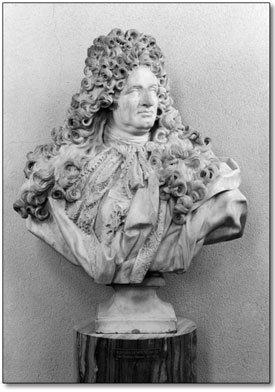| ||||||
Big boys and their toys
by Judith Reynolds If you’ve got it, flaunt it. Jules Hardouin-Mansart appears to be an arrogant man. Shown here in a 1703 marble portrait, he’s at the height of his power. As Louis XIV’s court architect, Hardouin-Mansart was largely responsible for Versailles. Here he is resplendent in an oversized wig, so popular at Louis’ balding court. His billowing lace collar and frothy waves of silk and brocade scream status. So does a porcelain pitcher with its elaborate bronze armature. So does a demure silk upholstered chair. So does a velvet-lined picnic box filled with demitasse and gold sugar tongs. The ewer belonged to Louis XV. The chair sat in Marie Antoinette’s boudoir. And the rosewood picnic box was XV’s present to Queen Marie Leczinska for finally giving birth to a prince. All of these objects sit on pedestals at the Denver Art Museum, courtesy of the Louvre in Paris. “Artisans & Kings: Selected Treasures from the Louvre” is a bit of a palace coup for Denver. It’s the newest blockbuster exhibition for the museum, and it will be up through the first week of January. There’s plenty of time to get tickets online, but I wouldn’t wait. Included in the exhibition are more than 125 paintings, sculpture and decorative objects. Some famous gems may draw you in, like Bernini’s bronze bust of Pope Urban VIII or paintings such as a Titian Venus or an Infanta by Velázquez. But surprise of surprises, it’s the way the organizers tell the story of power and privilege that’s ultimately captivating. Gates Foundation Curator of Painting and Sculpture Timothy Standring and his Denver team have selected paintings, pitchers and tapestries from the royal collections of the French monarchy now, of course, at the Louvre. After the Revolution in the late 18th century, the palace became the Musée du Louvre and housed the newly named “people’s collections.” The exhibition in Denver is fundamentally a story of royal patronage, but it’s more than whose silver finger bowl sat next to whose crystal goblet at the king’s table. This is a story of how three kings in particular used art to demonstrate, consolidate and reinforce political power. You may be dazzled by the luxury, but after you leave the exhibition, you’ll understand why the French Revolution erupted during the reign of the final Louis – XVI. When you see all that excess, you get it. The exhibit is organized around four themes: the politics of style, trappings of power, crafting a lifestyle, and royal collections. In each section, brief text panels show how the kings cultivated the production of ostentatious goods as emblems of status. Panels and ongoing live demonstrations reveal the intricacies of many a lost art. The demonstrations feature gilders, weavers, ceramists and marqueters. A succinct audio guide is also available. It features a narrator and other voices, including Standring, who translate art historical lingo into human conversation. It’s worth the time.
How did Paris come to Denver? “The exhibition has been five years in the making,” Standring said in an interview in the museum last week. “We’re planning three exhibitions with the Louvre. ‘Artisans & Kings’ is only the first. The other two will take us into 2009.” Standring noted that the Louvre and the United States share a lifespan of 200 years. “That’s one thing we have in common.” After the French Revolution, the Musée Central des Arts opened to the public in the Grande Galerie of a former royal palace, he said. Since that time, the evolution into one of the world’s great museums is a story unto itself. Today there are 35,000 works of art in the Louvre, and Standring credits the new director of the Louvre, Henri Loyrette (appointed in 2001), with the vision and courage to send parts of the collection out into the world. “Artisans & Kings” is the first international exhibition to be shown in Denver’s new museum wing, and its content has been entirely crafted by the DAM team. “We fashioned a show from the core collection of the Louvre,” Standring said. “We decided to focus on the royal collections and distill the narrative into four themes. I’m a little disappointed to see all the bonnets (Plexiglas cases for the three-dimensional objects), but this is today.” Standring’s central idea is abundantly clear and compelling: aesthetics can carry ideological messages. Throughout history, kings and other “deciders” have known how to use art and craft to reinforce status and display power. Emblematic crowns go hand in hand with an emperor’s arrogant smirk. A gold chariot is but two centuries away from a bullet-proof Mercedes. Power toys are power toys. Coats of arms, with their male and female halves conjoined, are the royal ancestors of our Presidential Seal. But make no mistake, the purpose always is to visually state who has the power. Exhibitions largely made up of decorative arts too often devolve into a study of materials and craftsmanship. “Artisans & Kings” has a political framework that resonates on a larger platform. The next time you see handcrafted alligator cowboy boots with an enameled Presidential seal, think about King Louis and his silk shoes. They’re only one step apart. •
|




